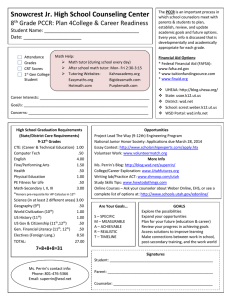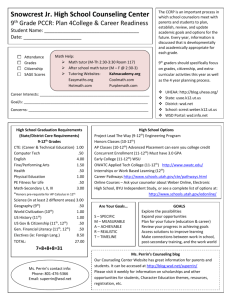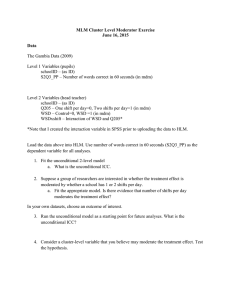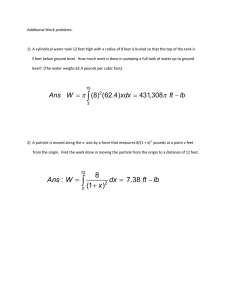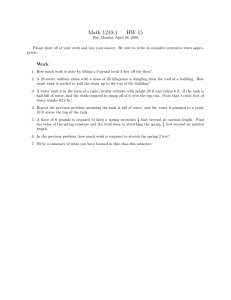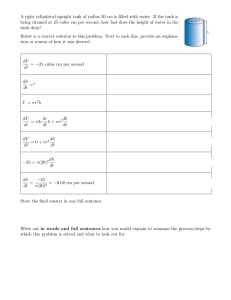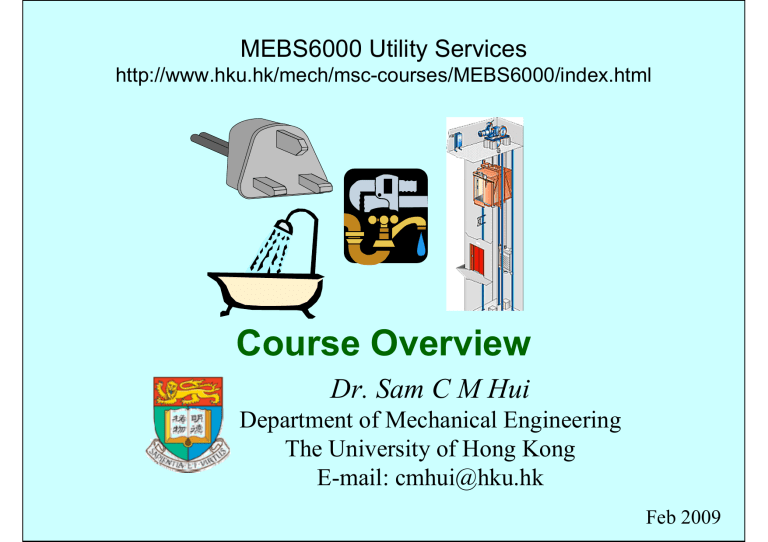
MEBS6000 Utility Services http://www.hku.hk/mech/msc-courses/MEBS6000/index.html Course Overview Dr. Sam C M Hui Department of Mechanical Engineering The University of Hong Kong E-mail: cmhui@hku.hk Feb 2009 Course Overview • Utility Services (公共設備) • “Utility” = a service used by the public • For example, electricity, water, gas, telephone • Educational Objectives: • To introduce students to various utility services installations in modern buildings • To enable students to design appropriate utility services systems aiming at achieving integration and co-ordination between disciplines Course Overview • Study Topics: • • • • • • • • 1) Lifts & escalators 2) L.V. electrical installation 3) Communication systems 4) Security and alarm systems 5) Cold and hot water systems 6) Steam systems 7) Sanitary & stormwater drainage 8) Sewage disposal Mr. W K Lee Dr. Sam Hui Course Overview • Teaching content (by Dr. Sam Hui) • • • • • Cold water supply Hot water supply Steam systems Stormwater & sanitary drainage Sewage disposal 給水排水 MEBS6000 Utility Services http://www.hku.hk/mech/msc-courses/MEBS6000/index.html Cold Water Supply Dr. Sam C M Hui Department of Mechanical Engineering The University of Hong Kong E-mail: cmhui@hku.hk Feb 2009 Contents • • • • • History of water supply in Hong Kong Water sources Water supply distribution Water tanks & pumps Water quality & management History of water supply in HK • Video presentation: "樓下閂水喉" (Restriction of Water Supply) [25 min.] • 1851: sinking of 5 wells in the “City of Victoria” • 1860: tanks constructed at Bonham Road • 1863: Pok Fu Lam reservoir ……… • Web links • History and Future of Water Supply in Hong Kong www.wsd.gov.hk/en/html/water/hkwidx.htm • 150 Years of Water Supply in Hong Kong www.info.gov.hk/water150/ History of water supply in Hong Kong (1946-2007) (Source: Water Supplies Department, www.wsd.gov.hk) History of water supply in Hong Kong (1946-2007) (cont’d) (Source: Water Supplies Department, www.wsd.gov.hk) (Source: Water Supplies Department, www.wsd.gov.hk) Reservoirs & water gathering grounds in Hong Kong Water sources • Surface & underground water sources: • Shallow wells • Sinkings in top water-bearing strata • Intermittent or land springs • From top water-bearing strata • Deep wells • Sinkings below the first impervious strata • Artesian wells and springs • The same source as deep wells • Lakes & rivers • Catchment of surface and subsoil water 飲 水 思 源 (Source: Hall, F. and Greeno, R., 2007. Building Services Handbook) Water sources • Water Supplies Department (WSD) • • • • • To plan & manage water resources & water supply systems To design & construct waterworks projects To operate & maintain water supply & distribution systems To control the quality of water supply to customers To enforce the Waterworks Ordinance & Regulations • Include vetting plumbing proposals for buildings (from ‘Licensed Plumbers’) • Water resources in HK • Rainfall from natural catchment + supply from Guangdong • 70% of water demand is now met by water from Dongjiang River • Sea water for flushing toilets (for over 80% population) Xinfengjiang Reservoir 新豐江水庫 Dongjiang 東江 Shenzhen Reservoir 深圳水庫 Muk Wu Pump Station (HK) 木湖泵站(香港) (Source: Water Supplies Department, www.wsd.gov.hk) Water pipes along the railway line (Source: Water Supplies Department, www.wsd.gov.hk) (Source: Water Supplies Department, www.wsd.gov.hk) (Source: Water Supplies Department, www.wsd.gov.hk) Salt water consumption in HK (2007) = 270 million cub.m (Source: Water Supplies Department, www.wsd.gov.hk) Existing seawater flushing situation & proposed extensions (Source: Water Supplies Department, www.wsd.gov.hk) The average fresh water consumption in one day in Hong Kong is (data based on year 2007): A. 1,310 litre/person B. 852 litre/person C. 374 litre/person D. 244 litre/person Water sources • Water for human consumption must be: • • • • Free from harmful bacteria & suspended matter Colourless Pleasant to taste For health reasons, moderately ‘hard’ (CaCO3) • Water storage & treatment process to ensure good water quality • Complies with World Health Organization (WHO) guidelines for drinking water Protection of Source (e.g. in reservoirs) Coagulation + Segmentation (mixing & clarifying) Filtration (e.g sand filters, pressure filters) Sterilization (e.g. by chlorine) Water Softening (e.g. by lime soda) Analysis of Water (e.g. chemical, physical & bacteriological) Typical water treatment process The water treatment process (Source: Water Supplies Department, www.wsd.gov.hk) Water sources • Typical water treatment process in HK • 1. Raw water • Comes from different sources, including reservoir(s) and Dongjiang water of Guangdong • 2. Mixing • Raw water is dosed at the mixing chamber with • • • • Hydrated lime to precondition the raw water Chlorine to control algae Alum to coagulate impurities Polyelectrolyte to improve the coagulation and flocculation of impurities Water sources • Typical water treatment process in HK (cont’d) • 3. Flocculation and Sedimentation • After mixing, water is passed to the clarifiers where coagulation and flocculation of the impurities in the water will occur • The dissolved alum coagulate impurities in the water into large particles where settle as sludge • The sludge is collected and conveyed to sludge thickening tanks for further treatment before disposal Water sources • Typical water treatment process in HK (cont’d) • 4. Rapid Gravity Filtration • Settled water from the clarifiers flows to the constant rate sand filters for removal of more finely divided suspensions • Periodically the filter beds are cleaned by backwashing with air and then water • 5. Clear Water Tanks • Chorine, fluoride and lime are dosed into the filtered water in the contact tanks and disinfect, fluoridate and control the alkalinity of the final treated water • The treated water is stored in the clear water tank before conveying to service reservoirs for distribution to people Water sources • Typical water treatment process in HK (cont’d) • 6. Pumping Facilities • Pumping station in the treatment to pump the water to the distribution • 7. Environmental Friendly Facilities • The washwater is collected in the recovery tanks for repumping to the inlet for recycling • Sludge produced is thickened by three circular sludge thickening tank using electrolyte as coagulant • Thickened sludge is compressed by membrane type filter presses into cakes for disposal at landlfill sites Water sources • Typical water treatment process in HK (cont’d) • 8. Water Quality Control • The quality of water is closely monitored by means of chemical, bacteriological and biological examinations of water samples taken • To comply with the Guidelines for Drinking Water Quality recommended by WHO, to ensure a safe and wholesome potable supply Water sources • Water charges in Hong Kong • Domestic consumers • • • • • • • Billed at 4-monthly intervals (121.64 days) 4 tiers with progressively increasing prices To discourage excessive and unnecessary use of water First tier: 12 cubic metres: free of charge Second tier: 31 cubic metres: $4.16 per cubic metre Third tier: 19 cubic metres: $6.45 per cubic metre Fourth tier: > 62 cubic metres: $9.05 per cubic metre Water sources • Water charges in Hong Kong (cont’d) • Non-domestic consumers • Billed at 4-monthly intervals (for large consumption consumers, billed at monthly intervals) • At a flat rate dependent on the purpose of the supply • For trade: $4.58 per cubic metre • For construction: $7.11 per cubic metre • For non ocean-going shipping: $4.58 per cubic metre • For ocean-going shipping: $10.93 per cubic metre Water sources • Water charges in Hong Kong (cont’d) • Flushing supplies • Sea water supply for flushing is free of charge • Fresh water supply for flushing is usually billed at 4monthly intervals • First tier: 30 cubic metres per flat: free of charge • Second tier: > 30 cubic metres per flat: $4.58 per cubic metre • Only one meter installed in each building to record the total consumption of all flats in the same building • Billed separately to the management office, agent, incorporated owner or development company Water sources • Water charges in Hong Kong (cont’d) • Sewage charges • For domestic consumers: at a 4-month interval: $1.31 per cubic metre, with an exemption for the first 12 cubic metres • For trade, business and manufacture consumers: $1.31 per cubic metre. Some trades are eligible for 30% discount (e.g. bleaching & dyeing, restaurants, softdrinks & ice-making industries) • For 30 types of trade/business/manufacture which discharge trade effluent, the consumer shall also pay a Trade Effluent Surcharge Water sources • Licensed Plumbers (持牌水喉匠) • A person licensed under the Waterworks Ordinance to construct, install, maintain, alter, repair or remove water supply plumbing • Grade I – for construction, installation, maintenance, alteration, repair or removal of a fire service or inside service of any type • Grade II – for maintenance and repair of a fire service or inside service; and for installation, maintenance, repair or removal of water appliances Water supply distribution • Distribution network of water supply • • • • • • • Main reservoir Pumping stations Water treatment plants Pumping substations Service reservoirs Trunk mains or service trunks Street mains or water mains (into buildings) Water supply distribution • Mains water supply • Size of the water mains • Pressure (or head) of water (20 or 30m head) • Such as a 75 mm diameter pipe fed from both ends or a 100 mm diameter pipe fed from one end • Min. head of 30 m for firefighting purposes • Max. head of 70 m to limit wastage and pipe noise • A ring circuit & a grid of pipes • To increase reliability & facilitate maintenance Ring main distribution (Source: Hall, F. and Greeno, R., 2007. Building Services Handbook) Water supply distribution • Pressure of water supplies in HK • Fresh water supply: 15-30 metres head • Salt water supply: 15 metres head • They are maintained in the distribution systems except at their extremities • Reduction of the minimum residual pressure (since 2007): lower from 30- to 20-metre head Water supply distribution • Water supply systems in buildings • Direct supply system: conveys water directly from water mains to the point of usage without any transit water storage tanks • Indirect supply system: conveys water from water mains to the point of usage through a transit water storage tank (usually a sump water tank and a roof water tank) • Potable/fresh water, flushing/salt water and water for fire services (e.g. FH/HR, sprinkler) Government land Building lot Government main (underground or under road, maintained by WSD) Control valve (Boundary valve) Connection to Inside service the main Individual consumer’s pipework & communal plumbing (maintained by individual consumers & property manager) Direct supply system (without storage tank) (Source: Water Supplies Department, www.wsd.gov.hk) (check leakage & consumption) Direct supply system (with storage tank) (Source: Water Supplies Department, www.wsd.gov.hk) (For a high-rise building, may require booster pumps & pneumatic vessel to ensure pressure for topmost floors) (Sump water tank or break tank) (Roof water tank) (Sump water pumps or upfeed pumps) Indirect supply system (with sump and pump) (Source: Water Supplies Department, www.wsd.gov.hk) (* Pressure vessel is used to adjust the supply pressure, if it is not practicable to control the pumps by level switches.) Indirect supply system (with pneumatic vessel) (Source: Water Supplies Department, www.wsd.gov.hk) Communal plumbing (maintained by property manager or agent) Individual consumer’s water main (maintained by consumer) Meter (consumer is responsible for its custody & WSD its maintenance) (Source: Water Supplies Department, www.wsd.gov.hk) Communal plumbing system (maintained by property management office or agent) Government main (maintained by WSD) (Source: Water Supplies Department, www.wsd.gov.hk) Comparison of direct and indirect water supply systems Direct supply Indirect supply - Less pipework, smaller or no water tank - More pipework, large water storage tank - No storage to satisfy peak demand period - Water storage to meet peak demand - Risk of contamination and - Less risk of adverse effects pressure fluctuation of mains by water mains - Not feasible for high-rise buildings due to main pressure - Can be used in high-rise buildings Water tanks & pumps • Water tanks • Materials: reinforced concrete, fibre glass, etc. • Reinforced concrete is the most common material used • Fibreglass storage cistern for potable water shall be of an approved type or certified, with no toxic materials and suitable for storage of potable water • Storage capacities: • • • • Assessment of water consumption & demand Proportion:- Sump tank : Roof tank = 1 : 3 Recommend to meet one-day (24 hours) demand Domestic supply – follows WSD recommendations Recommended storage capacities in water supply systems Domestic water supply with Flushing sump and pump supply using salt water Up to 10 flats > 10 flats Temporary mains fresh water for flushing (TMF) 135 litres/flat 90 litres Minimum 45 litres per flushing (total storage for each 1/2 day apparatus, including additional flat consumption minimum 250 sump tank) litres * For industrial use, recommended storage capacity is one-day demand. Water tank basic requirements (for a gravity supply) (Source: Garrett, R. H., 2008. Hot and Cold Water Supply) Water tanks & pumps • Cleansing of water storage tanks • Such as sump tank and roof tank • They should be cleansed once every three months • Maintenance of internal plumbing • WSD maintains the water supply distribution system up to the building lot boundaries • Internal & communal plumbing are maintained by the consumers Double sealed tank cover with lock Damaged water tank cover Rusty water tank cover (Source: Water Supplies Department, www.wsd.gov.hk) Water tank not cleaned Storage tank without proper maintenance & management Water tanks & pumps • Water pumps • Provide a duplicate set (duty + standby) • Pumping capacity >= designed out-flow of tank • Minimise vibration and noise problems • Adequate pipework support & anchor • Solid foundation • Common pump types • Horizontal end suction centrifugal • Vertical multistage centrifugal Water tanks & pumps • Pump control • Automatic control using pressure switches, level switches, high-level & low-level electrodes • Pump selector switch & ON/OFF/AUTO • Low-speed preferred (longer life & quiet) • Pump motor • Such as squirrel cage induction type • Overload protection (electrical) Typical pump room (Source: Garrett, R. H., 2008. Hot and Cold Water Supply) Typical pump room (Source: Garrett, R. H., 2008. Hot and Cold Water Supply) Water quality & management • Treated water supplied by WSD at the connection points fully complies with the WHO guidelines for drinking water • If the water is free from contamination within the plumbing system in a building, it is not necessary to use filter or purifier • If a filter or purifier is used, it should be properly cleaned & maintained. Non-return valve may be needed to prevent back-flowing (Source: Water Supplies Department, www.wsd.gov.hk) (Source: Water Supplies Department, www.wsd.gov.hk) (Source: Water Supplies Department, www.wsd.gov.hk) Water quality & management • Quality Water Recognition Scheme for Buildings (by WSD) • To encourage building owners to maintain their plumbing systems properly • www.wsd.gov.hk/en/html/promote/video8.htm • There are 3 grades of certificates: • Blue Certificates: New participation or continuous participation with less than 3 years • Silver Certificates: Continuous participation 3-5 years • Gold Certificates: Continuous participation >= 5 years Water quality & management • Since 2000, WSD has launched a programme to replace or rehabilitate the aged water mains • For both fresh water and salt water supplies • About 3,000 km of water mains (in a network of 7,600 km) to be completed in 15 years • Works are carried out in 4 stages www.wsd.gov.hk/en/html/edu/rehab/index.htm • Video aout the programme www.wsd.gov.hk/tc/html/edu/rehab/video9.htm Water quality & management • Total Water Management (TWM) strategy • Water demand management • • • • To enhance public education on water conservation To promote use of water saving devices To enhance water leakage control To extend use of seawater for toilet flushing • Water supply management • To strengthen protection of water resources • To actively consider water reclamation (reuse of greywater & rainwater harvesting) • To develop the option of seawater desalination (Source: Water Supplies Department, www.wsd.gov.hk) Water quality & management • Inspect and maintain plumbing to prevent water leaks • www.wsd.gov.hk/en/html/promote/video7.htm • Checking of water leakage: simple method • Turn off all water taps • Compare the water meter reading over a 30-minutes period • If the water meter registers flow when all water taps are turned off, it implies leaking • However, this method cannot detect very small leakage (seepage)
